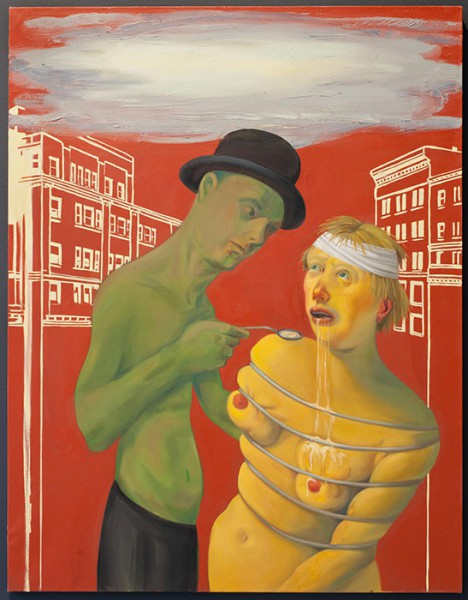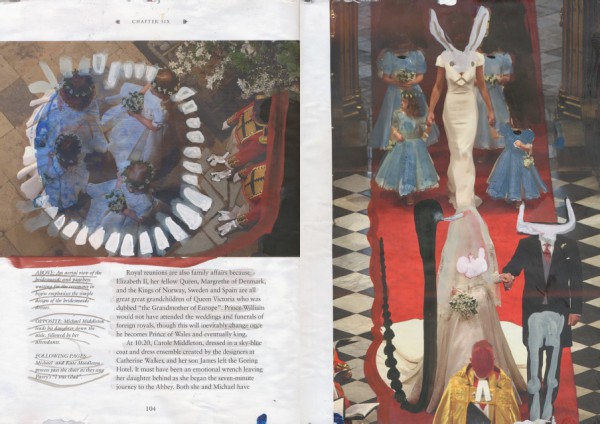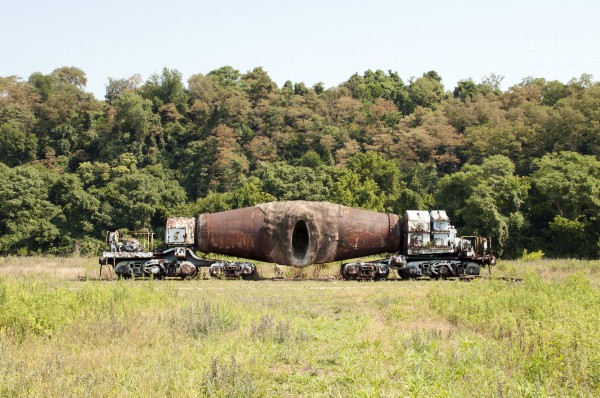It’s a Wide, Wild World of Art at the Carnegie International
Any time is a good time to visit the Carnegie Museum of Art, but now is a great time. The current edition of the Carnegie International—one of the world’s oldest and foremost recurring exhibitions of contemporary art from around the world—will finish its five-month run on March 16. The next one isn’t due for another four years. And the 2013-14 International is a dilly.

Q: What’s going on? A: This is “Commerce Feeds Creativity,” by Nicole Eisenman. (Image courtesy of the Hort Family Collection)
One of the most likable things about the show is that it has no Next-Big-Thing aspect to it. There is no central theme, nor any attempt to focus on trends that might define what is (sigh) “important” in art today.
What you get instead is a panorama of modern artistic life—a wildly divergent sampling of pieces in many different styles and media. In just one corner of the exhibition, within three adjoining spaces, it’s possible to experience a whole spectrum of reactions. You can see paintings and sculptures that make you laugh out loud (they’re among the works by Nicole Eisenman, winner of the Carnegie Prize for best artist in show). Then you step through a doorway into a coldly clinical photo collection that will rattle your thinking. (Taryn Simon’s simple shots are portraits of the girls and gear from various James Bond movies, done with a surprising twist. More on that later.) And from there, you can walk into a small gallery with haunting images that mesmerize.
That gallery includes two spooky yet lyrical videos by Amar Kanwar of India, plus a series of long rice-paper scrolls inked with fantastic drawings of surreal people and creatures. The rice papers look like artifacts from ancient China but are the work of the modern Chinese folk artist Guo Fengyi, who, until her recent death, was a retired factory worker.
A Show Both Wide and Deep
The sheer diversity of the International means you probably won’t like everything you see. I didn’t, and over the course of several visits, I eventually wound up breezing past some of the art to spend more time with the things that intrigued me. Luckily, the exhibition is designed for such selective in-depth viewing. Rather than putting together a broad but shallow hodgepodge of works, the show’s curators chose a fairly small sample of artists—35 from 19 countries—and gave them room to display either multiple pieces or a major, single-topic installation with sub-pieces.
For example, all of Gallery One houses works by Mladen Stilinovic of Croatia, giving you a show-within-the-show that brings out different facets of the artist’s quirky mentality. His written manifesto In Praise of Laziness declares, in part, that ”Artists in the West are not lazy and therefore not artists,” for “there is no art without laziness.” A nearby wall has pictures of Stilinovic demonstrating how to do it right, while another text work, the Dictionary–Pain, is an actual English dictionary he has altered to define “pain” from viewpoints that people rarely think of.
Also, this year’s International spills beyond the museum’s traditional galleries. There are exhibits in stairwells, corridors, even in the room with lockers for checking coats and valuables.
Better yet, the curators have greatly extended the scope and impact of the show by tying it to the past. They have “re-installed” (i.e., rearranged) the museum’s permanent collection of modern and contemporary art, highlighting works the museum acquired from previous Internationals. These are flagged with yellow labels, and, alongside other works from their respective periods, they tell powerful stories of how art has changed through the times.
It’s a long way from the lovely pear shapes of Mary Cassatt’s Young Women Picking Fruit, shown at the 1899 International, to Alberto Giacometti’s lean and angular sculpture Walking Man I, from the 1960 show. (Some critics saw Giacometti’s emaciated figures as reflecting the distress and spiritual emptiness of Europe after World War II.) Then, from the anything-goes 1990s, there are works like Chris Ofili’s The Adoration of Captain Shit and the Legend of the Black Stars (Third Version), featured in the 1999 International and created, in part, with Ofili’s signature painting material, elephant dung.
By all means visit the re-installed permanent collection. Meanwhile, allow me to extend this review by pointing out a few of my personal favorites, all but one from the current International.
Standouts and Must-Sees
Joel Sternfeld’s Sweet Earth: Experimental Utopias in America is a photo-and-text survey of 29 communities started by artists, environmentalists, religious groups, and others. The photos are very good—many of these places have (or, if now defunct, had) incredible architecture—and the well-written brief histories are fascinating. One could easily spend more than an hour with Sweet Earth, learning about “utopias” that range from the abandoned Drop City artists’ commune of the 1960s to Old Economy Village, founded by the Harmonites in the early 1800s in what is now Ambridge, Pa.
It’s hard to beat a seriously good artist who has a sense of humor. The paintings and sculptures by prize-winner Eisenman, ringing the balcony of the museum’s Hall of Sculpture, make up what you might call Circus Maximus. There are quick-take, one-gag paintings like I’m With Stupid, and more complex ones, such as Coping, a wonderfully literal rendition of what it feels like to slog through the muck of everyday cares and concerns. The sculptures are icing on the cake. Amid the museum’s casts of heroic Greek and Roman statues, Eisenman has inserted some not-so-heroic figures like the Prince of Swords, engrossed in his smartphone.
Two short videos are must-sees. In the current International, Amar Kanwar’s A Love Story builds unforgettable montages of mystically melancholy scenes. And in the permanent collection, don’t miss Paul Chan’s 17-minute digital animation from the 2004 show, Happiness (Finally) after 35,000 Years of Civilization (after Henry Darger and Charles Fourier). Is the title ironic? Well, yeah. But this mini-epic, done in the visual style of the extremely eccentric Darger, transcends the status of being just another bizarre dystopian fantasy. It is beautiful.
Also notable are the photo essay Faces and Phases by Zanele Muholi of South Africa, which won her the Fine Prize for best emerging artist; Pedro Reyes’s Disarm (Mechanized), an assembly of self-playing musical instruments made from parts of guns confiscated in the Mexican drug wars; and the Iranian exile Rokni Haerizadeh’s madcap riffs on the wedding of Britain’s Prince William.

Rokni Haerizadeh’s “The Royal Wedding” is an elaborate, page-by-page markup of “William and Catherine: The Royal Wedding Album” from Carlton Books. Visitors can thumb through all 144 pages. (Image courtesy of Gallery Isabelle van den Eynde, Dubai, and the artist)
Now for the James Bond room. According to the museum’s website, the photos here depict how “women, weapons, and vehicles” serve as “essential accessories to the myth of the seductive, powerful, and invincible Western male.” This might lead you to expect an impassioned feminist attack, but Simon has made her point more effectively—with spare, matter-of-fact photos and captions that simply present the facts.
The longer one looks at her photos of exotic weapons from the Bond movies, such as the Razor-Edged Bowler Hat and Bagpipe with Flame Thrower and Machine Gun, the sillier they seem. And the topper is what Simon has done with the Bond girls in films from the 1960s onward: Pussy Galore, Holly Goodhead, Octopussy, and their like. She has photographed the actresses as they are today. Honor Blackman (Pussy Galore) strikes an elegant pose and is still looking quite good; for a woman of nearly 90, she doesn’t look a day over 72. Grace Jones (May Day in A View to a Kill) appears as formidable as ever, but at 65 she is no longer an Amazon warrior in her prime, coming across as a fierce female Secretary of War.
The message isn’t that jaguars rule. It is that women are more than nubile young things, and I’ve never seen a better way of conveying that message.
Finally, if a recurring theme of any kind emerges from the exhibits in this International, it’s that there’s a lot of “statement” art. Numerous works comment on sociopolitical issues and/or on aspects of popular culture. Viewers who prefer a “purer” art that deals with truth, beauty, etc., may not care for this—but truth and beauty come in many forms and my statement to you is: See the show.
Closing Credits and Local Connections
Co-curators of the 2013-14 Carnegie International are Daniel Baumann, director of the Adolf Wölfli Foundation in Basel, Switzerland, and Dan Byers and Tina Kukielski of the Carnegie Museum of Art.
Some art has local tie-ins. For the photo essay Homesteading, Zoe Strauss set up shop on the main street in Homestead, Pa., taking pictures of landscapes and people there. And, to enjoy the Art Lending Collection, you’ll have to visit the Braddock Carnegie Library, where the North Braddock-based artists’ collective Transformazium has created a system that lets you borrow donated art works (including many by artists from the International) just as you’d check out a book or DVD. Lending will continue after the International ends.
The Carnegie Museum of Art is open from 10 a.m. to 5 p.m., with these exceptions: On Thursdays, it’s open until 8 p.m., Sunday hours are noon to 5 p.m., and the museum is CLOSED on Tuesdays. If you want to visit more than once—which I recommend, since a shorter viewing is better than an all-day marathon—consider buying a museum membership in lieu of paying repeated admission fees. 4400 Forbes Ave., Oakland; for details on the International, click here.
Mike Vargo is a longtime writer and editor based in Pittsburgh.
Share on Social Media
Follow Entertainment Central
Latest Stories
Sign up for the EC Newsletter










